The routine of the sailors at San Pedro de Tiquina is much like that of any navy around the world. They rise early for the morning’s drill – marching in parade formation or doing physical exercises, depending on the day – before a few hours of classroom instruction. Then they go out on to the water. “Sometimes we do an operation,” says Maria Isabel Mansilla, a 25-year-old instructor with the base’s scuba-diving team, “an amphibious assault or a reconnaissance mission.”
On other days, Mansilla’s unit might be set a more mundane, or sombre, task – hoisting a tree trunk out of the water or searching the shallows for the body of a missing person.
But the naval recruits here are unusual: their country is landlocked. Bolivia lost its only coastal territory – the arid Atacama region abutting the Pacific Ocean – in a war with Chile more than 130 years ago. As a result, Bolivia’s navy, whose modern incarnation dates back to 1966, is confined to searching the country’s jungle waterways for drug traffickers and smugglers; or, in the case of San Pedro de Tiquina, keeping watch over Lake Titicaca, 3,800 metres above sea level. The Centre for High-Altitude Scuba-Diving (CIBA) at the base is the highest in the world.
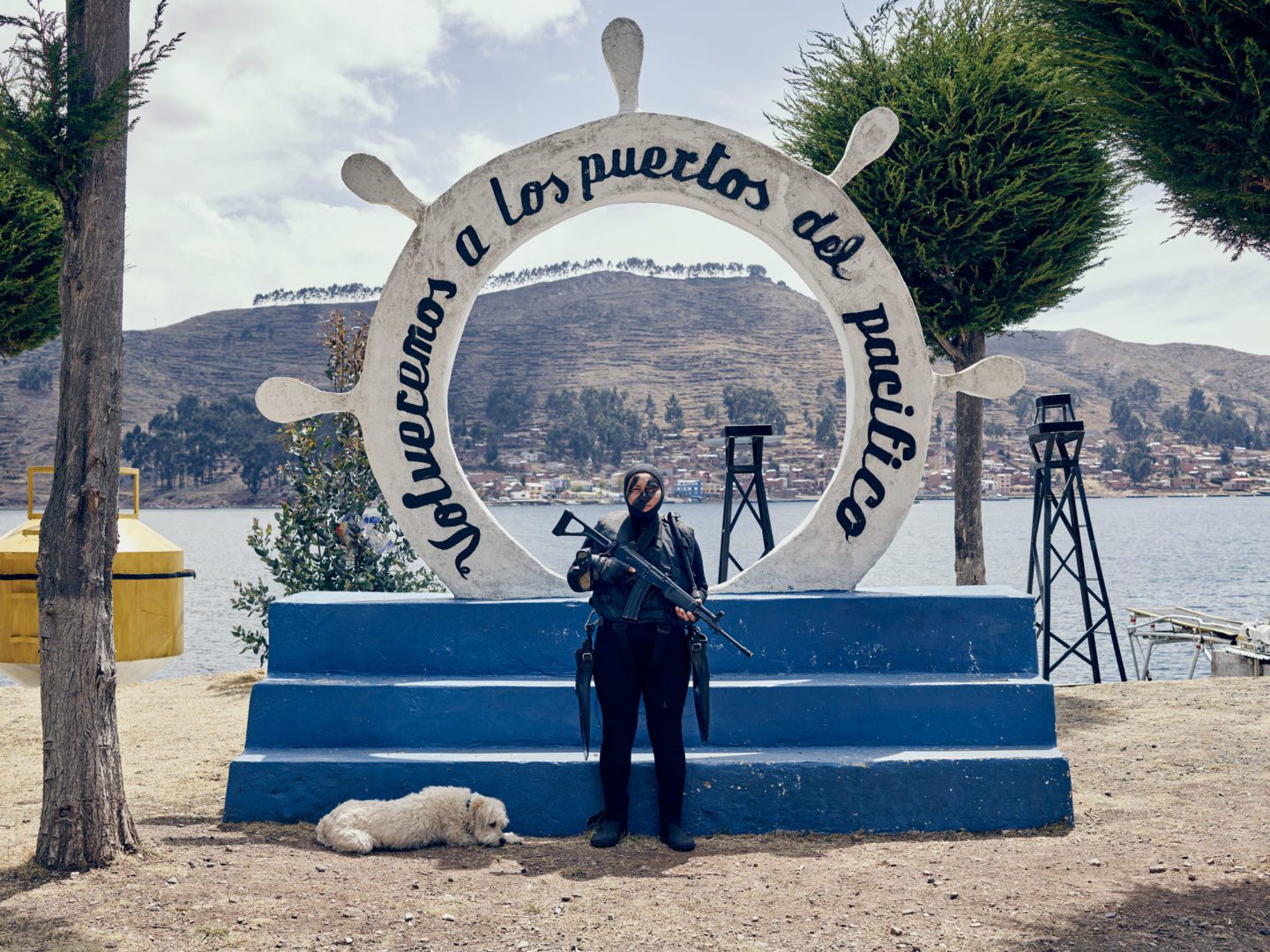
Like this sculpture – which reads “We will return to the Pacific” – Bolivia’s ‘naval hymn’ promises that the country will one day return to the Pacific Ocean ports it lost to Chile over 130 years ago. Maria Isabel Mansilla, wearing combat uniform, stands in front of it, before going to practice.
There are worse places to be, Mansilla readily concedes. The water – metallic grey in the morning, striking cobalt blue during the afternoon – turns a burnished gold in the evening, as the sun – which, according to Inca mythology, was born in the lake – arcs across the sky. “It’s pretty, isn’t it?” Mansilla remarks. Few boats other than the navy’s single ship, and the base’s smaller speedboats, disturb the surface. Beneath it, archaeologists believe, the remains of ancient civilisations are still waiting to be discovered. A series of Italian-led dives discovered a pre-Inca settlement at the bottom of the lake in 2000, and the scuba centre is currently teaching a group of Bolivian archaeologists how to dive so they can broaden the search.

The scuba-diving squad on combat practice emerge from the lake. However, the country’s armed forces are outnumbered and outgunned in comparison to its neighbours, with some of its equipment dating back to the Vietnam War.
Bolivia’s oceanless navy is often the butt of jokes in the region, and further afield. It has a fighting strength of a little over 5,000 and limited and dated armaments: glory would probably prove elusive in the unlikely event that conflict was to break out with one of Bolivia’s neighbours. Military pomp around the world always has a latent absurdity, but this is particularly acute in Bolivia on March 23rd, the ‘Day of the Sea’, which marks the annexation of its shoreline.
Bolivia’s sailors don pristine white uniforms for parades throughout the South American nation of 11 million people, singing the ‘Naval Hymn’, promising Bolivia’s eventual return to the sea.
The naval recruits here are unusual: their country is landlocked. Bolivia lost its only coastal territory more than 130 years ago.
Laurence Blair
Yet glib treatments of the country’s maritime aspirations miss the point. For one thing, members of the Bolivian navy are highly trained and committed. Gone are the days when the armed forces had to forcibly conscript recruits, often from Bolivia’s indigenous communities. In Rurrenabaque, on the edge of the Amazon, navy veteran Ernesto recalls a local dance in the 1980s being interrupted by military police vehicles screeching to a halt outside. “They piled all the men into the trucks, even those who’d already done their military service,” he says with a grim smile. One year of soldiering is still a formal obligation for all men aged between 17 and 22; but the number of volunteers has, in recent years, tended to outstrip the number of recruits that the armed forces can afford to take, making forced recruitment unnecessary.
Once in the navy, recruits don’t face an easy ride. The 13-week ‘tactical-military scuba course’, which Mansilla instructs, is one of the most rigorous within Bolivia’s armed forces; only a third of those who start it tend to finish. Those who do complete it talk of discovering new reserves of mental and physical endurance in order to withstand daily immersion in the frigid waters of the lake. If you spend longer than five minutes in the water without a wetsuit, you’re liable to start showing symptoms of hypothermia. And diving at this altitude is different to paddling about in the Caribbean. The air’s lower atmospheric pressure, and the lake’s fresh water, less dense than the ocean, require a different set of mental sums if divers are to avoid painful decompression sickness when emerging from the depths.
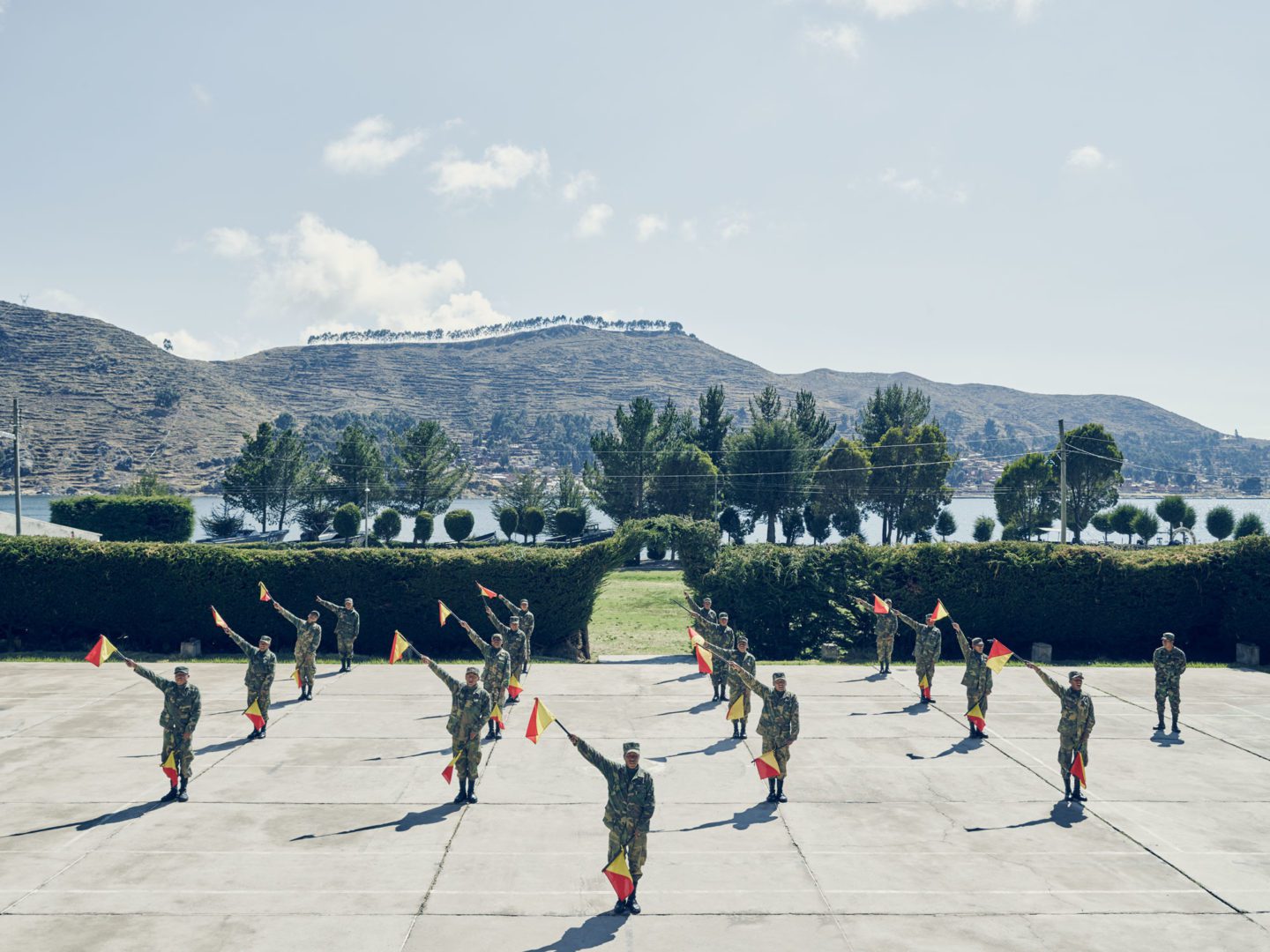
Navy students practice international maritime signals with semaphore flags at the Tiquina Naval Base in Bolivia.
Fortunately, when recruits aren’t hurling themselves backwards off a speeding boat, they can practice with pressure equivalent to up to 120 metres’ depth in the base’s immersion tank. Search and rescue operations, signalling lessons and personnel exchanges with Mexico, Spain, Peru and Argentina are all part of the training. “Above all, we’re trained to be prepared… both for rivers and the lake, and in all situations,” says Mansilla. Along with the training comes an extensive list of rules and regulations: members of Bolivia’s armed forces can be punished for no fewer than 166 separate infractions, from being drunk in uniform to failing to salute a superior officer properly while talking on a mobile phone.
San Pedro de Tiquina is little more than 100 kilometres from La Paz, the seat of Bolivia’s military high command. But discipline is naturally a little looser when the top brass is further away. In the case of Puerto Busch, a remote riverbank naval base in the humid Pantanal in the south-east of the country, the nearest town is four hours’ drive across a flood-prone mud track. When I arrive, Second Lieutenant Nicolas Espejo is playing a shirtless game of kick-ups with his entire command: a sergeant and six teenage recruits. Their rifles are visible behind a single locked door in the small building which serves as a base, raised on concrete pillars above the swamp. Beneath it they’ve built a rudimentary set of weights out of concrete and poles. “We’re here on rotation for five months,” Espejo says. “It took us a while to get used to the climate: the heat, the storms, the mosquitoes.”
But exercises continue: orienteering, weapons exercises, physical instruction. Perhaps mainly for my benefit, the sergeant takes the recruits out on to the roof of a rusting pontoon on the river for a round of star jumps, press-ups and sit-ups. In the course of their expeditions out into the swamp, the sailors take the opportunity to forage for additional supplies, including the giant rodent, capybara. “It tastes a bit like chicken,” the lieutenant explains over a less exotic lunch of rice and actual chicken. I quiz the adolescent sailors about their experience of the navy. They’re awkward and shy, like any teenagers, but clearly benefiting from their slightly surreal posting. One of them has just learned to swim in the muddy, fast-flowing river outside.
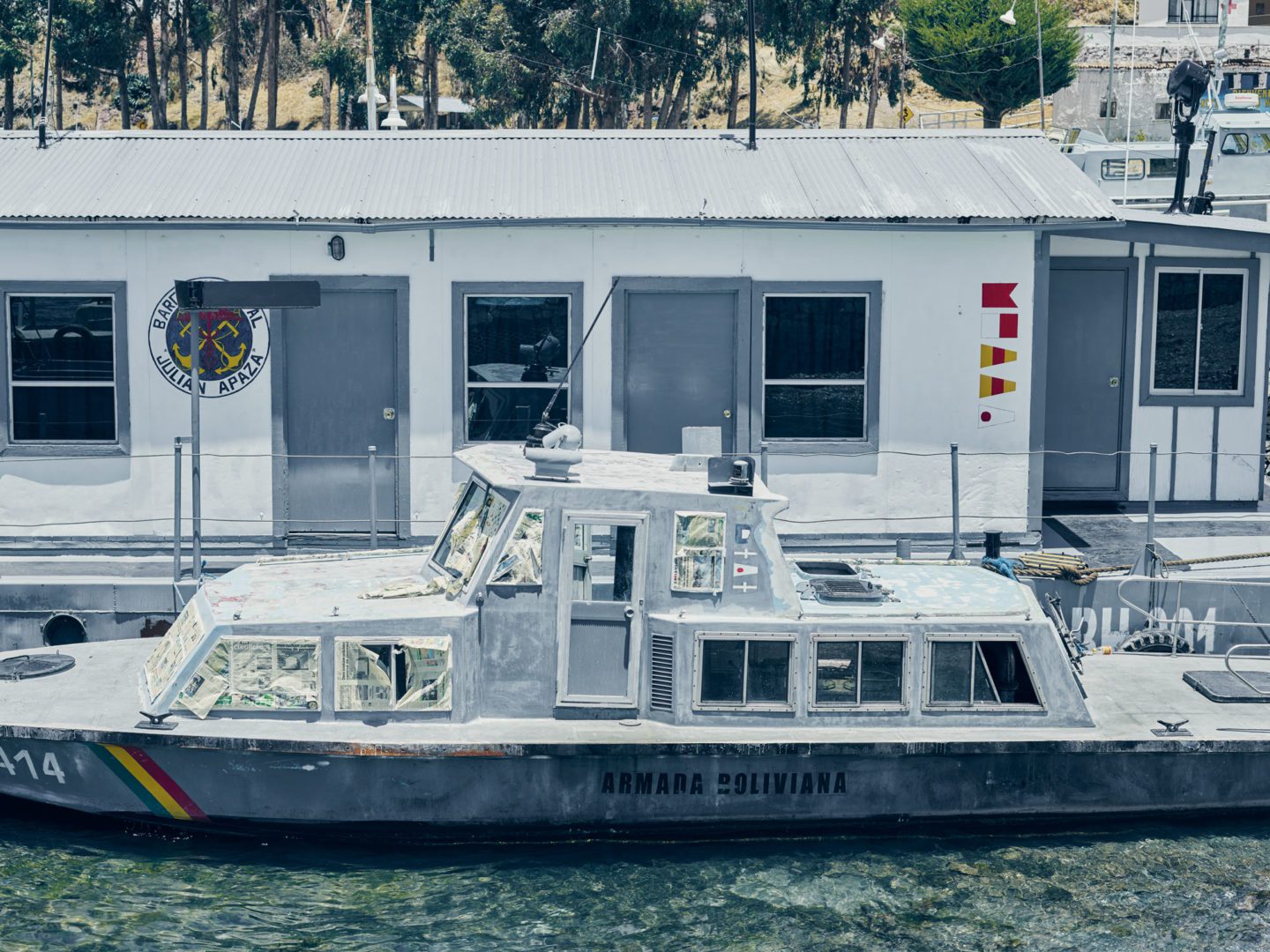
The Bolivian navy has over 150 vessels, but only a few of these are of a significant size. The Boston Whaler speedboats – manufactured in Florida and, in this case, bought second-hand from the Chinese navy and undergoing repairs – make up the backbone of its force.
Bolivia’s navy is worth taking seriously for another reason. It illustrates the dramatic social and political transformation that Bolivia has undergone in the past 10 to 15 years. In 2006, Evo Morales, the country’s first indigenous president, came to power having led years of protests against an establishment perceived to be controlled by business elites and outside powers. Soon after, his nationalisation of the country’s crucial oil and natural gas sectors, buoyed by high global commodity prices, paved the way for a spending splurge on social programmes targeting the country’s rural and indigenous poor. Illiteracy and poverty have plummeted, GDP growth has accelerated and social mobility has risen, changing the face of the country.
“Bolivia is in the process of accelerated urbanisation, which is a common theme throughout Latin America,” explains John Crabtree, an expert on Bolivian politics at Oxford University. “In a country that’s more rural than most, the process has been fast and furious.” Morales’s successive administrations since 2006 have also placed heavy emphasis on promoting gender and racial equality – notably in the country’s new constitution of 2009 that defines Bolivia as a “plurinational state” with 36 officially recognised indigenous languages. There are limits to this progress, Crabtree cautions, notably on indigenous autonomy. “But there has been a shift in power, towards some of those groups and towards greater self-determination.”
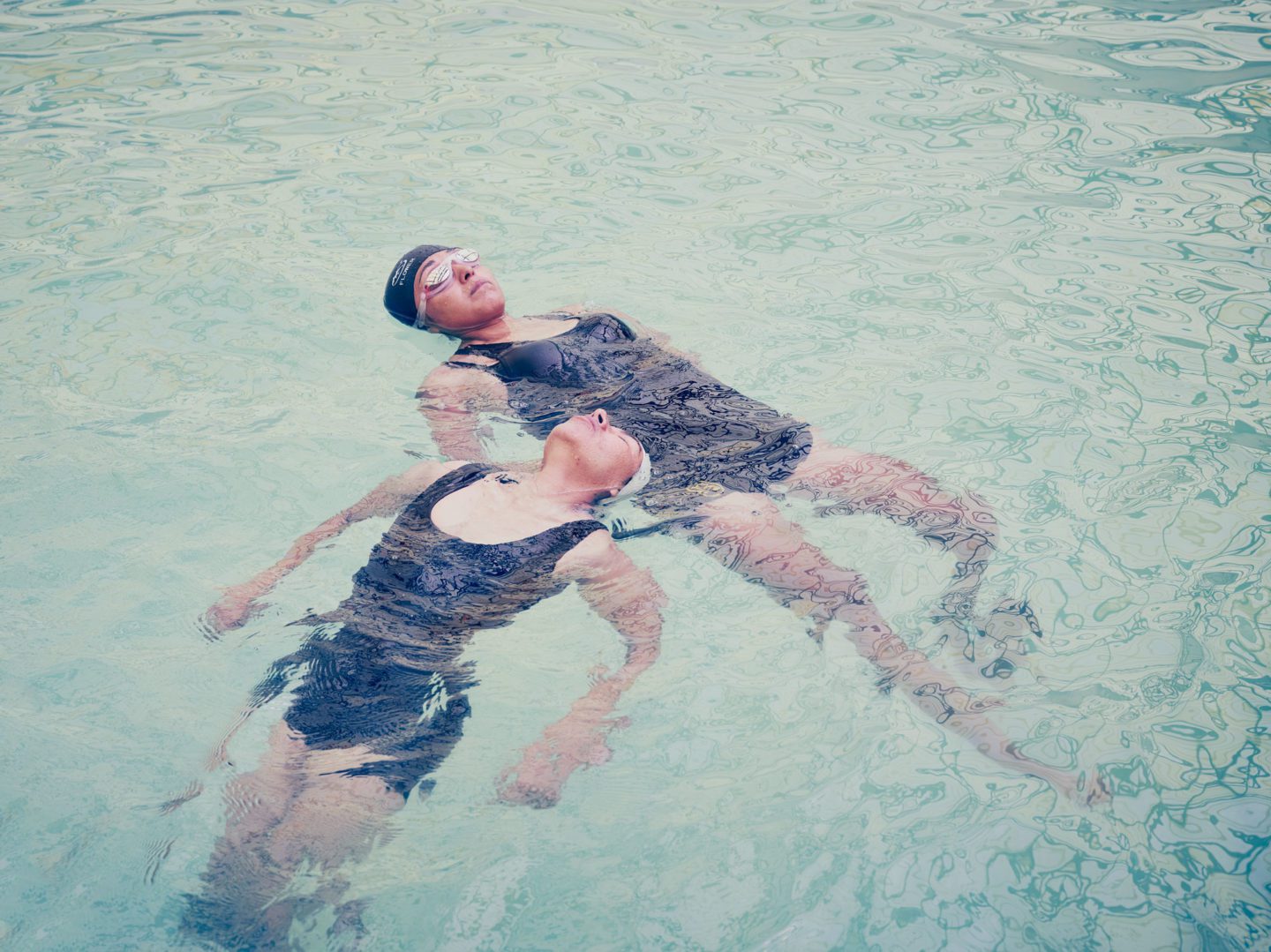
Some recruits are unable to swim when they first enlist in the navy. Others have been making full use of Bolivia’s lakes and rivers from an early age. Here they practice floatation methods during their first week of training in the base’s pool.
The armed forces are both a reflection and an agent of this change. Behind the navy’s boats flutter an ensign bearing both the traditional Bolivian tricolour and the wiphala of Qulla Suyu, a grid of technicolour pixels representing the southern quarter of the traditional Inca empire. Women and members of indigenous groups are slowly appearing in the upper echelons of the military. But on a lower level, young Bolivians who sign up to the military are often deployed to the opposite corner of the vast country, developing a greater affinity and understanding of their homeland, when their parents and grandparents would have scarcely left their native province.
Mansilla, for example, originally hails from Guayaramerín, a small town on the north-eastern border with Brazil. “I learned to swim by myself,” she says. “There are lots of natural swimming places in the area. In the east the temperature can go from 30 to 36 degrees.” (The temperature around Lake Titicaca, by contrast, often falls below freezing between May and September.) Espejo has effectively made the journey in the opposite direction, going from the cool altiplano city of La Paz to the humid marshes of the south-east. Although the first cohort of women recruits entered the navy in 2012, Mansilla is the only woman serving at the base at San Pedro de Tiquina, of a total of nearly 50 personnel. But she reports never having faced any form of discrimination. “Here in Bolivia, there’s gender equality, and this applies to the armed forces too. The treatment in the Bolivian navy is exactly the same.”

An officer stands aside from anniversary celebrations to take a call.
If anything, Bolivia’s navy is likely to keep growing in symbolic importance beyond its diminutive size. Morales, now the Western hemisphere’s longest-serving sitting leader, narrowly lost a referendum in 2016 that would have allowed him to run for another term in office in 2019. His Movement Towards Socialism (MAS) party, however, is considering other constitutional loopholes which may allow him to run. Meanwhile, the International Court of Justice is likely to rule in the coming years on a lawsuit brought by Bolivia, designed to force Chile to negotiate over returning sovereign access to the Pacific. In this tense political environment, Morales is likely to increasingly deploy the well-turned-out ranks of Bolivia’s sailors as a symbol of the country’s new-found confidence and apparent unity under his leadership. “The nationalist card is an old one in Bolivian politics, but an effective one,” says Crabtree. “In that particular gambit, the navy has a role.”
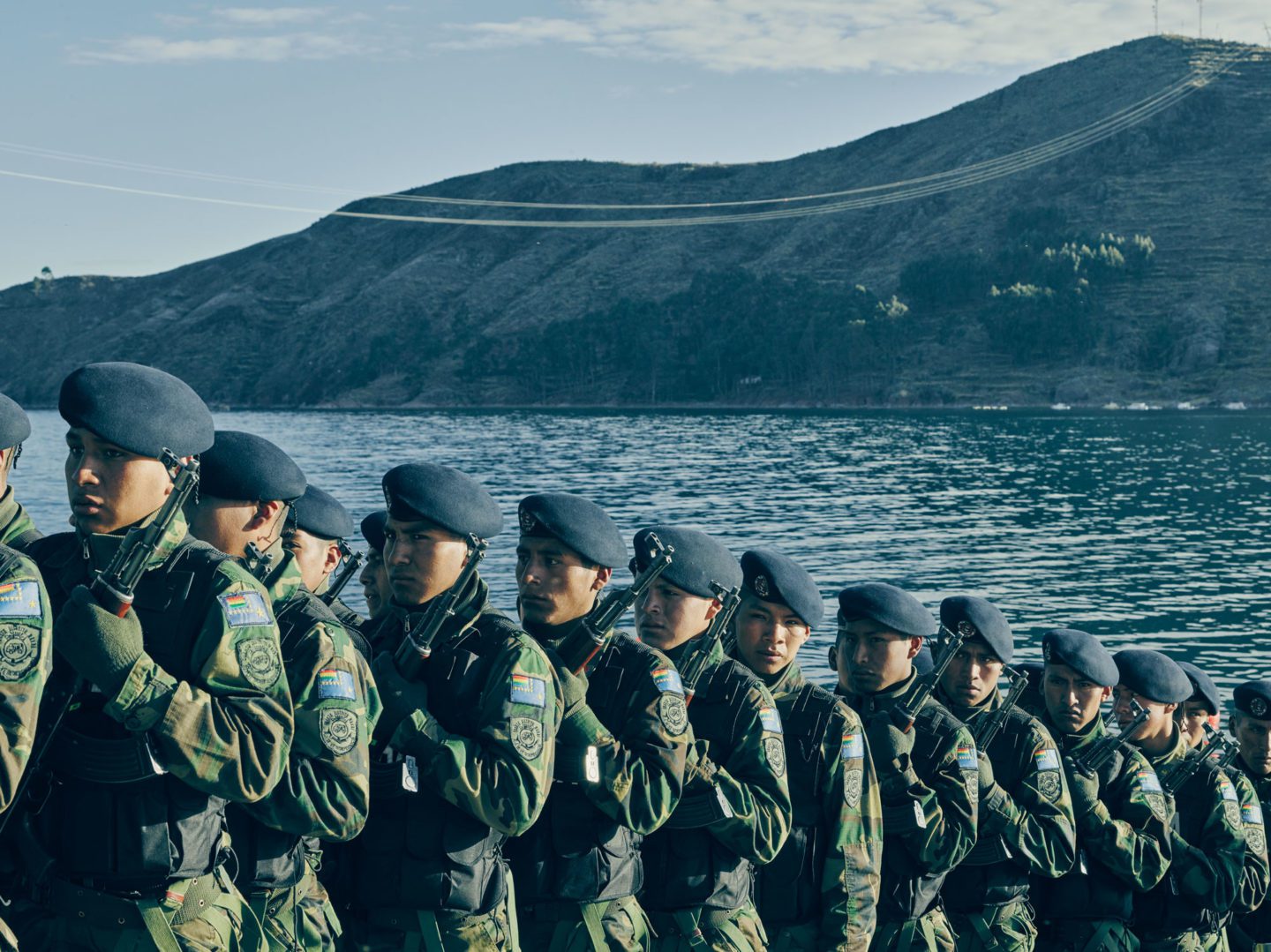
Bolivian soldiers in formation arrive at the San Pedro Tiquina Naval Base to celebrate the 48th anniversary of the foundation of the base.
But such considerations are far from the thoughts of most of Bolivia’s sailors, it seems. For Mansilla, any worries she might have evaporate as soon as she goes out on to the lake and slips into its sharp waters. When asked how she feels when she’s diving, the clipped, courteous answers of a military professional give way to something more lyrical. “In reality, scuba is like another world, a very beautiful one, for anyone who can do it… It feels like flying, and your feelings from above disappear.”











